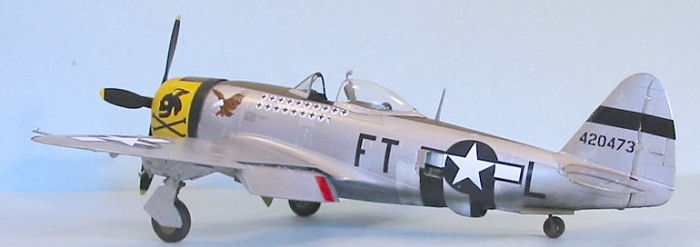
| KIT #: | 61096 |
| PRICE: | $¥2800 from www.hlj.com |
| DECALS: | Three options |
| REVIEWER: | Tom Cleaver |
| NOTES: | Built as a P-47D-30 |

| HISTORY |
Writing in the "Flight Journal," P-47 special issue, famed Grumman test pilot Corky Meyer - the last actual "airplane person" to head a major airplane company - named the P‑47 Thunderbolt the "best fighter of World War II ‑ ETO." As he pointed out, it had high performance, yet a wartime‑trained 200‑hour pilot could fly it. It had a well laid‑out cockpit in which all the controls, switches, and instruments were handily located. It exceeded at three of the four performance parameters he established: air combat capability, fighter escort capability, ground support capability and photo‑reconnaissance (it only missed on the latter).
With 15,683 Thunderbolts produced between 1941‑45,the P-47 is the most‑produced American fighter ever. Republic delivered one in 1941, 532 in 1942, 4,428 in 1943, 7,065 in 1944 and 3,657 in 1945. 730 were operated by the RAF in Southeast Asia, while 446 flew for the French Air Force in Europe. The only theater of war in which the Thunderbolt did not fight was the Aleutians. It is telling that the two top‑scoring American fighter pilots in the ETO both flew P‑47s exclusively, and all 10 of the top P‑47 aces in the ETO survived the war. By D‑Day there were 17 P‑47 Fighter Groups stationed in England, and in the next eleven months, they swept across western Europe like an aerial scythe.
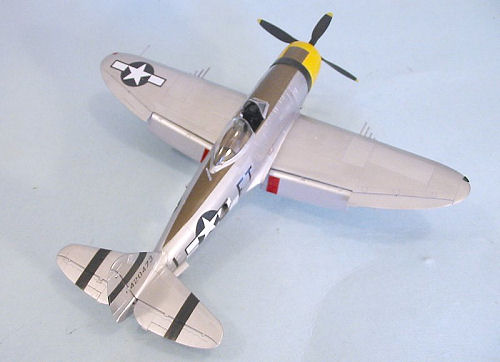 The P‑47 Thunderbolt acquired its name "Jug" when the P‑47D‑25 series appeared
on operations. With the upper fuselage cut down to make way for a
teardrop‑shaped "bubbletop" canopy, the fuselage took on the shape of a milk
bottle, hence "Jug." It was later claimed the name came from the word
"Juggernaut," and in light of the career of the bubbletop Thunderbolts across
Western Europe in the period between D‑Day and V‑E Day, that sounds reasonable.
But to Thunderbolt pilots who were there when the "bubbletop" replaced the
"razorback," "Jug" meant milk jug.
The P‑47 Thunderbolt acquired its name "Jug" when the P‑47D‑25 series appeared
on operations. With the upper fuselage cut down to make way for a
teardrop‑shaped "bubbletop" canopy, the fuselage took on the shape of a milk
bottle, hence "Jug." It was later claimed the name came from the word
"Juggernaut," and in light of the career of the bubbletop Thunderbolts across
Western Europe in the period between D‑Day and V‑E Day, that sounds reasonable.
But to Thunderbolt pilots who were there when the "bubbletop" replaced the
"razorback," "Jug" meant milk jug.
The first "bubbletop" Thunderbolt was the YP‑47K, which began life as a P‑47D‑11RE, and was the second fighter fitted with a "bubble" canopy after the British Hawker Typhoon. Originally scheduled for production as the P‑47L, the "super 'Bolt" - as pilots called it originally - began appearing in England in May, 1944, under the designation P‑47D‑25-RE. With an R‑2800‑59 engine putting out 2,300 h.p. under war emergency rating, and swinging a Hamilton Standard Hydromatic propeller of 13 feet, 1 7/8 inches diameter, the airplane had increased tankage and the ability to carry a 150‑gallon drop tank on the centerline shackles. At first, only flight leaders ‑ group commanders and squadron commanders ‑ received the new airplane. By the end of the summer of 1944, with the high losses sustained in ground attack missions during the Battle of Normandy, the "bubbletop" P‑47D‑25,‑26, -27 -28 and -30 Thunderbolts from Farmingdale (RE) and Evansville (RA) were the standard fighter bomber of the U.S. 9th Army Air Force.
The P-47D-30, the last sub-type to see combat in large numbers, differed from previous P-47s in having blunt-nosed ailerons to improve control at high speeds installed, elimination of the ring-and-bead gun sight, an electrical release mechanism for external stores and permanent sway braces for external stores, a factory-supplied dive flap at 30 percent of chord to eliminate high-mach buffeting in dives, introduction of the 13 foot Curtiss-Electric prop with larger “paddle” blades, and the introduction of a standard rearview mirror for the bubble canopy. The cockpit differed in having a “flat” floor and different radios and instrument panel.
Scenes From The P‑47 Juggernaut Across Europe:
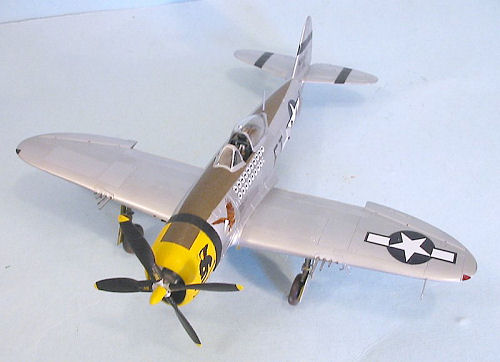 Once the American forces were established on the continent. many small airfields
appeared across northern France to support the operations of the Thunderbolts.
The fields the P‑47s flew from were generally temporary ‑ a short runway that
was either made of pierced‑steel‑planking, or dirt. When a P‑47 pilot sat
at the end of a 3,500 foot runway, carrying a full ammo load, two 500‑pound
bombs and a 110‑gallon drop tank, successful take‑off could be problematic,
especially if it had rained recently.
Once the American forces were established on the continent. many small airfields
appeared across northern France to support the operations of the Thunderbolts.
The fields the P‑47s flew from were generally temporary ‑ a short runway that
was either made of pierced‑steel‑planking, or dirt. When a P‑47 pilot sat
at the end of a 3,500 foot runway, carrying a full ammo load, two 500‑pound
bombs and a 110‑gallon drop tank, successful take‑off could be problematic,
especially if it had rained recently.
Jack Reynolds of the 412th Fighter Squadron of the 373rd Fighter Group remembered the "Rules for Takeoff" that were posted at the ops office:
1. Line up on the runway with the canopy open.
2. Stand on the brakes.
3. Pull the stick all the way back.
4. Push the throttle, mixture, prop control, and turbo to the fire wall.
5. When the tail comes off the ground, ease off the brakes and push the stick forward so you are moving with the tail in the air.
6. With one hand on the throttle quadrant,
7. With one hand on the bomb release,
8. With one hand on the wheel retract handle,
9. With one hand on the cowl flap closer handle,
10. With one hand on the elevator trim wheel,
11. With one hand on the safety belt release,
12. With one hand on the water injection button,
13. With one hand, cross yourself.
14. When you reach the end of the runway, ease the stick back and retract the wheels.
As fellow 412th Fighter Squadron veteran John Rutherford remembers, "There was a very familiar sight at most strips whenever a shot‑up P‑47 would crash‑land. Usually, the pilot would jump out and signal he was OK. Before the dust had settled, an enterprising crew chief would be making off with the canopy for his plane. The instruments would go next, before the salvage crew got there. It beat requisitioning parts and waiting forever."
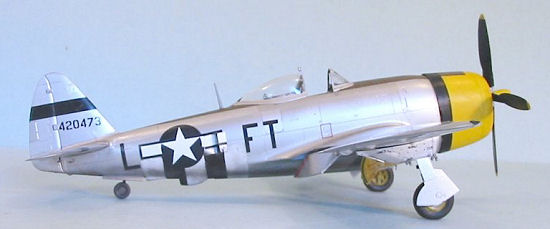 When an accident happened on one of these strips, the result was that flight
operations were canceled until the wreckage was cleared. For those in the air,
this meant finding another small crowded airfield to land at. As Rutherford
recalls, "We came back one time to find our strip inoperative and were vectored
to a neighboring strip about 30 miles away. The home group there was trying to
land, along with another stranded group of P‑47s. We had no radio contact with
the controller, so we all got in a tight landing pattern to try and get on the
ground. I recall flying close formation with several strange P‑47s on the
crosswind and approach legs. The strip was too narrow to take more than one at
a time, so the one lucky pilot who was closest to the ground at the decisive
moment, would put down. The rest had to go around again. The ceiling was about
1,000 feet and dropping. There was a small church with a steeple and cross
about half a mile from the end of the runway we were landing on.
When an accident happened on one of these strips, the result was that flight
operations were canceled until the wreckage was cleared. For those in the air,
this meant finding another small crowded airfield to land at. As Rutherford
recalls, "We came back one time to find our strip inoperative and were vectored
to a neighboring strip about 30 miles away. The home group there was trying to
land, along with another stranded group of P‑47s. We had no radio contact with
the controller, so we all got in a tight landing pattern to try and get on the
ground. I recall flying close formation with several strange P‑47s on the
crosswind and approach legs. The strip was too narrow to take more than one at
a time, so the one lucky pilot who was closest to the ground at the decisive
moment, would put down. The rest had to go around again. The ceiling was about
1,000 feet and dropping. There was a small church with a steeple and cross
about half a mile from the end of the runway we were landing on.
One Thunderbolt managed to knock off the cross, but landed safely. Then another P‑47 hit the steeple and knocked a few feet off it, and landed safely. A third hit the steeple and reduced it to about half its original height, and landed safely. Thunderbolts were tough, to take that and still land!"
While there were more than a few moments of "sheer terror" to be faced by a Thunderbolt pilot, not all of them happened under enemy fire. Jack Reynolds remembers an incident that wasboth terrifying and hilarious in the same moment. "We had a replacement pilot named Ted Buckley in the 411th Squadron who loved French champagne, cognac, you name it. One morning, after a long night in Brussels, he was assigned to make a test hop. He did it, breathing pure oxygen to get the cobwebs out of his brain. Upon landing, he allowed one wheel to get off the runway and hit a crater, and the P‑47 flipped on its back, burying the top of the canopy in the dirt so he couldn't get out. A group of us ran out to help. We found him drenched with gasoline, hanging upside down in his harness, cursing like a fiend. Before we had time to do anything, Lt. Ramon Franzalia, from Group Headquarters, ran in under the wing, drew his .45 automatic, pointed it at Buckley's head and said, "Don’t' worry Buck, if it starts to burn I'll shoot you!" The rest of us lifted the tail, opened the canopy and released Ole Buck. He got out, swore at Franzalia, and lunged at him but fell down. Franzalia took off running and wasn't seen for two days until Ole Buck had cooled down."
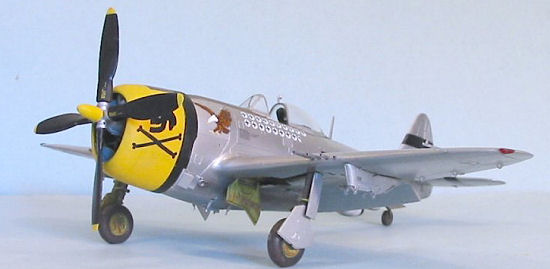 Occasionally, war could become completely absurd. Jack Reynolds recalls a
particularly‑memorable mission: "Col. James McCarthy, the Group C.O., was
leading a squadron of 16 P‑47s on an armed recon flight, each carrying three 500
pound bombs and a full load of 500 rounds per gun. They had been cruising for
two hours over France without seeing anything. Finally, someone spotted a lone
German on a motorcycle high‑tailing it down a country lane.
Occasionally, war could become completely absurd. Jack Reynolds recalls a
particularly‑memorable mission: "Col. James McCarthy, the Group C.O., was
leading a squadron of 16 P‑47s on an armed recon flight, each carrying three 500
pound bombs and a full load of 500 rounds per gun. They had been cruising for
two hours over France without seeing anything. Finally, someone spotted a lone
German on a motorcycle high‑tailing it down a country lane.
"In desperation, McCarthy sent one flight down to drop one 500‑pounder on the motorcycle. The pilot missed. Then each man in the first flight came around and dropped one 500 pounder on the motorcycle. All three missed! Then they each went back and dropped the remaining two bombs each. They all missed! The motorcycle was still speeding though the French countryside.
"Then each came back and made a strafing run at the motorcycle. They missed again! The next three flights came down in turn and did the same thing, and they all missed! Just count it up: 1,500 pounds of bombs each, 4,000 rounds of 50‑caliber each. Sixteen P‑47s made a total of 48 passes, dropping 24,000 pounds of bombs, and firing off 64,000 rounds from 128 machine guns ‑ and they all missed! And all they were shooting at was one lousy German on one lousy motorcycle!! What a story he had to tell back at the barracks! He must have been the luckiest guy in the whole German Army."
Archie Maltby, a line pilot of the 388th Fighter Squadron of the 365th Fighter Group, remembered what it was like to fly in the Battle of the Bulge: "When the attack first came, with all the bad weather, we would take off into a 500‑foot ceiling, and climb on instruments to 18,000 feet or so before breaking out. We were supporting the paratroopers at Bastogne, which is at an altitude of 3,500 feet. We'd get over the area, and drop back into the clouds on instruments. If we hadn't broken out by the time we got down to 4,500 feet, we had to climb back up, fly home, and let down again, all on instruments. That's damn hard to do in a P‑47, and we lost five guys before the weather changed. It was wonderful the day the sky broke and we could give those paratroopers the support they needed! Once the skies broke, we had the most lucrative hunting of the war. It was a burning mess out there as we hit everything they had."
Only one fighter unit of the Ninth Air Force used the P-51 Mustang - the 354th “Pioneer Mustang” Group. Following their move to the continent shortly after D-Day, the group experienced increased losses on ground attack missions, due to the vulnerability of the liquid-cooled Merlin engine to ground fire, as compared to the radial engined P-47, which could have cylinders shot off and still get home. During October 1944, just at the time Glenn T. Eagleston returned from leave and assumed command of the 353rd Fighter Squadron, the group lost their P-51 Mustangs and was assigned P-47D Thunderbolts, all brand-new P-47D-28-RE and P-47D-30-RE aircraft.
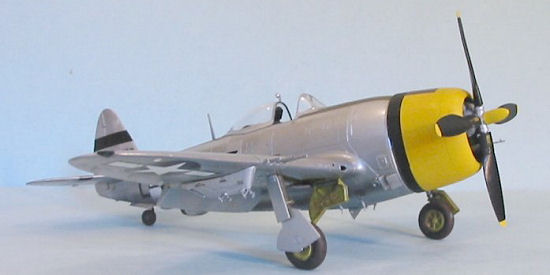 By
the end of October, the pilots had successfully transitioned to the P-47. In
early November, Eagleston led the squadron’s first P-47 combat mission, during
which they found enemy fighters and shot down nine of them. To the squadron
there was nothing unusual about that, but Ninth Air Force Fighter Command was
delighted because no Ninth Air Force Thunderbolt squadron had ever done that
before. However, during the rest of their four-month sojourn with the P-47, the
354th had its lowest scoring period of its wartime service, though it
saw plenty of action providing ground support during the Battle of the Bulge,
and one big day of air combat on December 12. The pilots were all happy when
Ninth Fighter Command relented in late February 1945 and they were re-equipped
with P-51s.
By
the end of October, the pilots had successfully transitioned to the P-47. In
early November, Eagleston led the squadron’s first P-47 combat mission, during
which they found enemy fighters and shot down nine of them. To the squadron
there was nothing unusual about that, but Ninth Air Force Fighter Command was
delighted because no Ninth Air Force Thunderbolt squadron had ever done that
before. However, during the rest of their four-month sojourn with the P-47, the
354th had its lowest scoring period of its wartime service, though it
saw plenty of action providing ground support during the Battle of the Bulge,
and one big day of air combat on December 12. The pilots were all happy when
Ninth Fighter Command relented in late February 1945 and they were re-equipped
with P-51s.
Operating at low altitude, right in the front lines where flak was heavy, many Thunderbolt pilots died in their airplanes. Every one of the P‑47 units involved in the fight across Europe after the invasion suffered more than 100 percent casualties in killed and wounded during the eleven months between D‑Day and V‑E Day. Archie Maltby remembered the day the war ended. "On May
8th, 1945, when we got the word it was over, I was in the squadron operations tent. I looked over at the roster board, and of the thirty‑six pilots assigned to the 388th Fighter Squadron,
there was me and two others who had flown the D‑Day missions. All the others I'd crossed the Channel with that morning weregone. Ten or twelve had finished their tours and made it home;the rest had been shot down, dead or prisoners."
| THE KIT |
This
kit of the P-47M differs from the previous P-47D bubbletop kits with the
provision of an extra sprue that has a different upper rear fuselage and
vertical fin, with includes the option of the early dorsal fin applied to P-47Ds
as well as the later dorsal fin used by the P-47N. Additional parts on this
sprue include an engine front for the R-2800-57 that powered the P-47M, as well
as lower wing inserts that have the dive brakes and the landing light moved to
the outer left wingtip. It should be noted that the
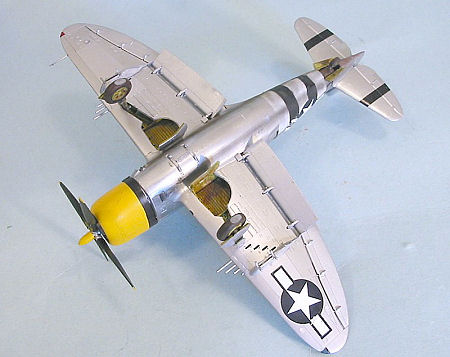 kit calls out for the wrong
magnetos to do the R-2800-57, since the “turtleback” mags were used on the
R-2800-59 engine; the round mags supplied on other sprues are correct for this
engine. The different cockpit floor and sidewalls associated with the P-47D-30
onwards are also on this sprue.
kit calls out for the wrong
magnetos to do the R-2800-57, since the “turtleback” mags were used on the
R-2800-59 engine; the round mags supplied on other sprues are correct for this
engine. The different cockpit floor and sidewalls associated with the P-47D-30
onwards are also on this sprue.
Overall, with the additional parts supplied in this kit, it is possible to use this release to build any bubbletop P-47 from the P-47D-25 to the P-47D-40, as well as the early P-47M, since the first release rear-fuselage/vertical fin part without the dorsal extension is still here.
Decals are the usual thick Tamiya release, and provide markings for two of the deep-purple/black P-47Ms flown by the 61st Squadron and one of the two-tone blue P-47Ms flown by the 63rd Squadron of the 56th Fighter Group, the only unit to use the P-47M operationally.
For myself, I decided I would build a model of the well-known P-47D-30-RE flown by Major Glenn T. Eagleston when he was C.O. of the 353rd Fighter Squadron of the 354th Fighter Group, using the Cutting Edge decal sheet 48-231. With this addition, I now have models of Eagleston’s P-51B, his last P-51D, and the F-86A he flew in Korea, as well as this P-47D.
| CONSTRUCTION |
Construction on this kit began with painting all the detail parts for the
cockpit, the engine, the wheel wells and landing gear. The cockpit parts were
painted with Tamiya "Deep Green," agood match for "Dull Dark Green," while the
gear wells, interior of the gear doors and the wheel rims were painted with
Tamiya "Yellow Green", a perfect "Yellow Zinc Chromate.” The gear
 legs were
painted Olive Drab; Tamiya says "silver," but the Army Tech Order quoted in
"Camouflage and Markings: P‑47 Thunderbolt in Europe" specifies Olive Drab. Once
all was dry, a light "wash" of thinned Tamiya "Smoke" was applied to highlight
detail, then the parts were given a coat of Xtracrylix flat varnish.
legs were
painted Olive Drab; Tamiya says "silver," but the Army Tech Order quoted in
"Camouflage and Markings: P‑47 Thunderbolt in Europe" specifies Olive Drab. Once
all was dry, a light "wash" of thinned Tamiya "Smoke" was applied to highlight
detail, then the parts were given a coat of Xtracrylix flat varnish.
The cockpit is as well‑detailed "out of the box" as any resin aftermarket set I have seen. I painted the "black boxes" and instrument panel in Tamiya "semi‑gloss black," and highlighted the black boxes with a brush dipped lightly in SNJ polishing powder; I used the kit decals for the instrument panel. I finished off the cockpit assembly by using Cutting Edge posable resin seat belts.
While all that was drying, I assembled the wings. Remember that you have to decide before gluing the flaps together whether you will pose them up or down, since you have to glue in the hinges at that point before gluing top and bottom halves together.
I attached the upper rear fuselage and fin parts to their respective fuselage halves before assembly. I then glued the cockpit together, and attached it to the left fuselage half, then glued the fuselage together. I needed some Mr. Surfacer 500 to get rid of the centerline seam.
I left off attaching the fuselage sway braces until final detail assembly, since they are easily broken off when the model is handled during construction and painting.
I assembled the engine, but left the cowling and the flap parts alone, deciding to assemble them after they were painted, so as to avoid a lot of masking.
When the fuselage was assembled, I attached the wings and the horizontal stabilizers. I think the entire construction phase ‑ including the pre‑painting of detail parts ‑ took under four hours total including drying time for the paint and time for the instrument panel decal to set up. This is a tribute to the excellent production design of the kit.
| COLORS & MARKINGS |
Painting:
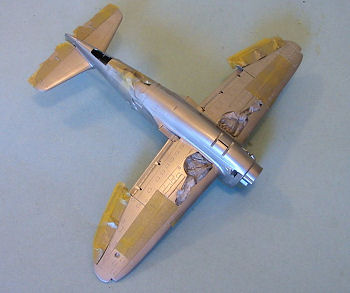 After painting the cowling and lower fuselage white, I painted the engine
cowling yellow. While that was drying, I did the lower fuselage “D-Day
stripes,” then masked them off. With the black paint still in the cup, I
painted the cowling flaps and masked off the engine cowling to paint the lower
rear black and be ready for the anti-glare panel. I then painted the Olive Drab
anti-glare panels on the upper fuselage and cowling. When all was dry,
everything was masked off.
After painting the cowling and lower fuselage white, I painted the engine
cowling yellow. While that was drying, I did the lower fuselage “D-Day
stripes,” then masked them off. With the black paint still in the cup, I
painted the cowling flaps and masked off the engine cowling to paint the lower
rear black and be ready for the anti-glare panel. I then painted the Olive Drab
anti-glare panels on the upper fuselage and cowling. When all was dry,
everything was masked off.
I
gave the model an overall coat of SNJ Aluminum. When that was dry, I masked off
various parts like the control surfaces and the gun bay covers, then applied an
overall coat of Alclad II “Duralumin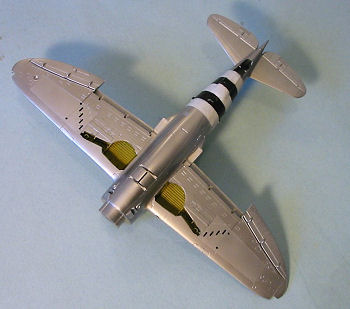 um.” When that was dry, I masked off some
other panels and gave them a coat of Alclad II “Aluminum.” This turned out to
be so closely similar to the SNJ paint that you cannot tell the difference
unless the model is in bright light. I also used some of the SNJ powder on some
other panels, so that I ended up with a “multi-hue” natural metal finish.
um.” When that was dry, I masked off some
other panels and gave them a coat of Alclad II “Aluminum.” This turned out to
be so closely similar to the SNJ paint that you cannot tell the difference
unless the model is in bright light. I also used some of the SNJ powder on some
other panels, so that I ended up with a “multi-hue” natural metal finish.
Decals:
The Cutting Edge decals went on without problem. The sheet includes two skull-and-crossbones decals for both sides of the cowling, but the only photo I have of Eagleston’s airplane is of the left side, which has the marking. Other photos of other P-47s of the 353rd Squadron taken from the right side show that the skull and crossbones was only applied to the left side of the cowling. This was standard practice throughout the war with airplanes of the 354th Fighter Group, to only apply markings on the left side. I decided to go with “group tradition” and leave off the marking on the right side of the cowling.
| FINAL CONSTRUCTION |
I applied Tamiya "Smoke" for the exhaust stains and did them heavily, since the one photo of Eagleston’s airplane shows the underside to be pretty dirty.
I attached the late gun sight and the canopy in the open
position, and attached the landing gear and gear doors. I “muddied up” the wheels, since that photo shows they were operating under “forward field conditions” in winter. The flaps were attached in the down position, which is the easiest way to mount them with this kit. With the blast tubes and prop attached, the model was finished.
| CONCLUSIONS |
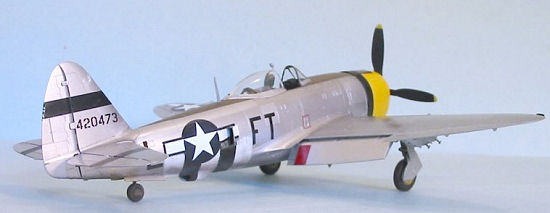 Tamiya's propellers - they supply all four types used by the P-47D - are far
superior to those of Hasegawa. I like the fact that with this kit, you can now
do any P-47D “bubbletop” version, which was one thing I liked about the Hasegawa
kits over the earlier releases of this kit. Overall, the Tamiya kit is the best
P-47 in this scale for ease of construction and overall accuracy.
Tamiya's propellers - they supply all four types used by the P-47D - are far
superior to those of Hasegawa. I like the fact that with this kit, you can now
do any P-47D “bubbletop” version, which was one thing I liked about the Hasegawa
kits over the earlier releases of this kit. Overall, the Tamiya kit is the best
P-47 in this scale for ease of construction and overall accuracy.
I would say I like these Thunderbolts as much as I like the Tamiya Corsair and Wildcat, which also are honeys to build out of the box; with this kit, there is nothing to correct, such as the step cutout in the flap of the Corsair or the cockpit floor of the Wildcat. This is going to be one of those kits you can build and build. Buy all the decals out there, and hoard them for all the future builds!
| REFERENCES |
"Scenes From the P‑47 Juggernaut Across Europe" originally appear as episodes in the articles "From D‑Day to V‑E Day" and "Tail‑End Charlie" both written by Thomas McKelvey Cleaver, published in the "P‑47 Thunderbolt Special" from Flight Journal.
January 2006
Thanks to HobbyLink Japan for the review copy. Get yours at "Japanese prices" at www.hlj.com
If you would like your product reviewed fairly and fairly quickly, please contact the editor or see other details in the Note to Contributors.